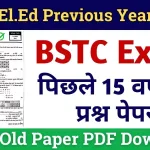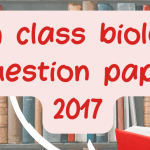AECS (Atomic Energy Central Schools) question papers are essential resources for students preparing for exams. Covering various subjects, these questions and answers help in building a solid foundation. This guide provides subject-wise questions and answers to support students’ learning and boost confidence for exams.
English Questions and Answers
Question: What is a noun?
Answer: A noun is the name of a person, place, thing, or idea.
Question: Define an adjective.
Answer: An adjective is a word that describes or modifies a noun or pronoun.
Question: What are the types of sentences?
Answer: The types of sentences are declarative, interrogative, imperative, and exclamatory.
Question: What is the difference between active and passive voice?
Answer: In active voice, the subject performs the action. In passive voice, the subject receives the action.
Question: What is a verb?
Answer: A verb is a word that shows an action, state, or occurrence.
Question: Define an adverb.
Answer: An adverb is a word that modifies a verb, an adjective, or another adverb.
Question: What is a pronoun?
Answer: A pronoun is a word that replaces a noun to avoid repetition.
Question: What is a preposition?
Answer: A preposition shows the relationship between a noun or pronoun and other words in a sentence.
Question: What is the function of conjunctions?
Answer: Conjunctions connect words, phrases, or clauses in a sentence.
Question: What is a clause?
Answer: A clause is a group of words with a subject and a verb that forms part of a sentence.
Question: Define subject and predicate.
Answer: The subject is who or what the sentence is about. The predicate tells what the subject does.
Question: What is direct speech?
Answer: Direct speech quotes the exact words spoken by someone, within quotation marks.
Question: What is indirect speech?
Answer: Indirect speech reports what someone said without quoting their exact words.
Question: What are homophones?
Answer: Homophones are words that sound the same but have different meanings and spellings.
Question: Define synonyms.
Answer: Synonyms are words with similar meanings.
Question: Define antonyms.
Answer: Antonyms are words with opposite meanings.
Question: What is the difference between simple and compound sentences?
Answer: Simple sentences have one independent clause, while compound sentences have two or more independent clauses.
Question: What is a metaphor?
Answer: A metaphor is a figure of speech comparing two unlike things without using “like” or “as.”
Question: What is a simile?
Answer: A simile compares two unlike things using “like” or “as.”
Mathematics Questions and Answers
Question: What is a prime number?
Answer: A prime number is a number greater than 1 with no divisors other than 1 and itself.
Question: Define a composite number.
Answer: A composite number is a number greater than 1 with more than two factors.
Question: What is the formula for the area of a rectangle?
Answer: The formula for the area of a rectangle is length × breadth.
Question: Define perimeter.
Answer: Perimeter is the total length of the boundary of a 2D shape.
Question: What is the value of pi?
Answer: The value of pi (π) is approximately 3.14159.
Question: What is a fraction?
Answer: A fraction represents a part of a whole, written as a/b where a and b are integers.
Question: What is the difference between proper and improper fractions?
Answer: A proper fraction has a numerator smaller than the denominator, while an improper fraction has a numerator equal to or larger than the denominator.
Question: What is a decimal?
Answer: A decimal is a number with a whole part and a fractional part separated by a decimal point.
Question: What is an equation?
Answer: An equation is a mathematical statement that shows equality between two expressions.
Question: What is the Pythagorean theorem?
Answer: The Pythagorean theorem states that in a right triangle, the square of the hypotenuse equals the sum of the squares of the other two sides.
Question: Define percentage.
Answer: A percentage is a fraction of 100, expressed with the symbol %.
Question: What is a polygon?
Answer: A polygon is a closed figure with three or more straight sides.
Question: What is the formula for the area of a triangle?
Answer: The formula for the area of a triangle is ½ × base × height.
Question: What are parallel lines?
Answer: Parallel lines are lines in a plane that never intersect.
Question: What is a perpendicular line?
Answer: A perpendicular line intersects another line at a 90-degree angle.
Question: Define the term mean in statistics.
Answer: The mean is the average of a set of numbers, calculated by dividing the sum of the numbers by the count of numbers.
Question: What is mode in statistics?
Answer: The mode is the number that appears most frequently in a data set.
Question: Define median in statistics.
Answer: The median is the middle value in a data set when arranged in ascending or descending order.
Question: What is a circle?
Answer: A circle is a shape with all points equidistant from its center.
Question: What is the formula for circumference of a circle?
Answer: The formula for the circumference of a circle is 2πr, where r is the radius.
Science Questions and Answers
Question: What is photosynthesis?
Answer: Photosynthesis is the process by which green plants use sunlight to make food from carbon dioxide and water.
Question: What is the function of the heart?
Answer: The heart pumps blood throughout the body, delivering oxygen and nutrients.
Question: Define matter.
Answer: Matter is anything that has mass and occupies space.
Question: What is an atom?
Answer: An atom is the smallest unit of an element, consisting of protons, neutrons, and electrons.
Question: What is the law of conservation of energy?
Answer: The law of conservation of energy states that energy cannot be created or destroyed, only transformed.
Question: What is gravity?
Answer: Gravity is the force that attracts objects toward the center of the Earth.
Question: Define friction.
Answer: Friction is the resistance encountered when one object moves over another.
Question: What is the function of the digestive system?
Answer: The digestive system breaks down food into nutrients that the body can absorb.
Question: What are the three states of matter?
Answer: The three states of matter are solid, liquid, and gas.
Question: What is an ecosystem?
Answer: An ecosystem is a community of living organisms and their interactions with their environment.
Question: What is a renewable resource?
Answer: A renewable resource is a natural resource that can be replenished naturally over time.
Question: Define evaporation.
Answer: Evaporation is the process of a liquid turning into a gas due to heat.
Question: What is a chemical reaction?
Answer: A chemical reaction is a process in which substances change to form new substances.
Question: What is the role of chlorophyll?
Answer: Chlorophyll helps plants capture sunlight for photosynthesis.
Question: What are antibiotics?
Answer: Antibiotics are medicines that kill or inhibit the growth of bacteria.
Question: Define biodiversity.
Answer: Biodiversity is the variety of life forms within a given ecosystem or on Earth.
Question: What is the boiling point of water?
Answer: The boiling point of water is 100°C or 212°F at standard atmospheric pressure.
Question: What is an electric circuit?
Answer: An electric circuit is a closed path through which electric current flows.
Question: What is the function of the nervous system?
Answer: The nervous system controls and coordinates body activities and responses.
AECS question papers cover multiple subjects, aiding students in a comprehensive understanding of concepts. By practicing these questions, learners can enhance their knowledge and prepare confidently for their exams. Use these questions as a guide to excel in studies.
Latest Posts
- Step-by-step guide to download and apply for jee mains admit card 202
- Comprehensive 2025 government holidays and recruitment details for job seekers
- JEE Mains Admit Card 2025: Your Step-by-Step Guide to Downloading the Hall Ticket
- Everything You Need to Know About 2025 Government Holidays Recruitment
- Comprehensive Guide to rrb d group recruitment 2025 – Eligibility, Vacancies, and Application
- Detailed guide to nps trust recruitment 2025 vacancies, eligibility and apply process
- Comprehensive guide to hpcl recruitment 2025 notification, vacancies, and application process
- ignou bed admission 2025 complete recruitment guide with eligibility and process
- Comprehensive Guide to Indian Army Agniveer Recruitment 2025 Notification and Jobs
- Everything You Must Know About CBSE Board Exams 2025 Changes & New Rules






